9 Bold Predictions for Moving & the Housing Market in 2024

Americans move a lot — once about every 5 years, in fact.
But those moves looked different this year. Owner moves slowed to a crawl, making 2023 the slowest year for home sales in 30 years. While high interest rates kept a damper on sales, renters moved on from their leases at higher rates than the year before. The average move size fell, and moving companies shuttered.
What will moves in 2024 look like?
From moving patterns impacting the upcoming presidential race, to a shift back to the Rust Belt, to Gen Z deciding the next hot cities via Tik Tok – we predict some interesting changes ahead.
1. We Predict Recent Domestic Migration Patterns will Heavily Impact the 2024 Election
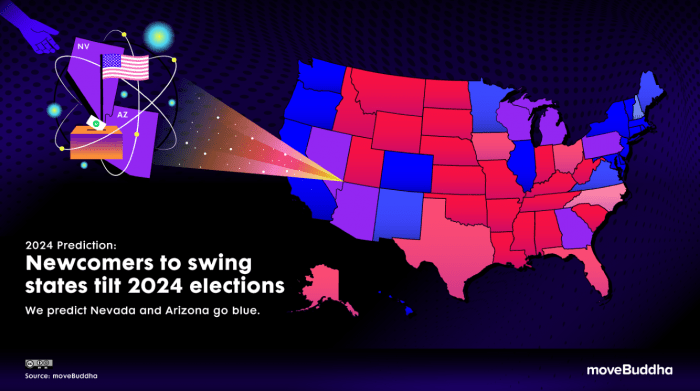
We’ll see more swing states swinging as pandemic-era moves shift the demographics of the country. It’ll become especially noticeable in big in-migration winners, like the Desert Southwest.
According to Paul Bentz, a researcher and strategist at HighGround, an Arizona public affairs firm, “You’ve got the suburban areas, which is really [like] the battleground states.” With those neighborhoods welcoming the majority of new residents, especially from blue-leaning California, the state’s election results are up for grabs. Immigrant voters are also making their mark on states, with implications for future elections.
Here at moveBuddha we’re making a bold call that the invasion of Californians to Nevada and Arizona will cause those two swing states to go blue. Other swing states like Georgia, Pennsylvania, Michigan and Wisconsin? Too tough to call.
2. Migrations will Shift back to the Rust Belt
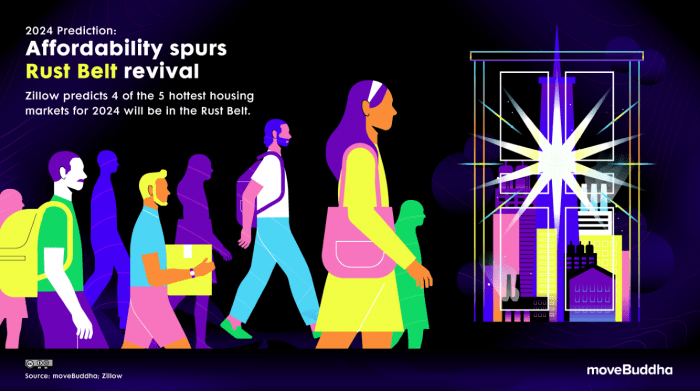
Madison (WI), Detroit (MI), and Grand Rapids (MI) will see a revival of interest from movers in 2024. Akron (OH) and Fort Wayne (IN) probably will, too.
It’s affordable and among the safest in a time of climate change — we’re talking about Midwest post-industrial urban cities. We’re not alone in this prediction; Zillow also predicts Buffalo, Cincinnati, Columbus, and Indianapolis will top the housing market charts in the months ahead.
“The relative affordability does play a factor,” Bank of America Economist Anna Zhou said of the trend of millennials eyeing longstanding population losers like Cleveland, Ohio. Why? Some trend-watchers note that millennials in their 30s are looking to nostalgic spots often near their undergraduate universities and for safe, friendly cities to raise children.
Further, for those worried about climate change and its impact on water scarcity, rising sea levels, and wildfires – the Midwest and Rust Belt have virtually none of those problems.
3. Gen Z will Decide the Next Hot Destinations

This up-and-coming generation will reshape American migration as pandemic exceptionalism wanes. Some segments are seeking affordability first, but they’re not willing to sacrifice a great scene. Look for Gen Z to start picking the next Boomtowns by moving in superclusters to places like mountain and college towns, where they can indulge in nature and the arts.
Surveys have shown this generation was showing interest in outdoor amenities in places like Salt Lake City, Oklahoma City, and Birmingham, Alabama. US census data has also pointed to college towns as prime destinations for Americans 18 to 24, even if they’re not attending school. Places like Columbia, South Carolina, and Madison, Wisconsin make the list. We can’t predict which hotspots will reign supreme by the year’s end. But we’re sure of this: they’ll share great outdoor recreation, top arts and music venues, and a diverse economy scene for new grads.
4. Dropping Mortgage Rates will Increase Home Sales & Moving Volume
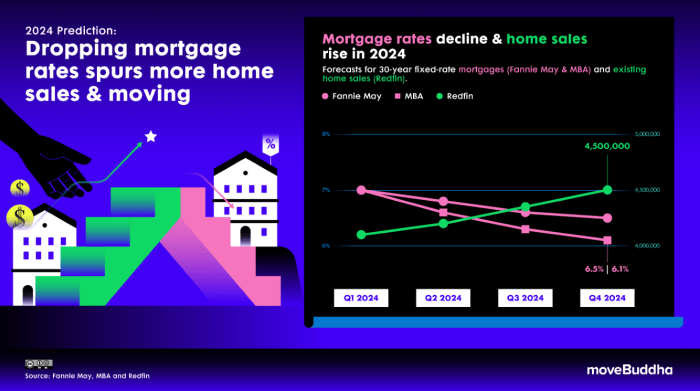
We predict a rebound in home sales and moving activity in 2024.
Redfin predicts expects “4.3 million sales in 2024, up 5% year over year.”
As mortgage interest rates top out and begin slowly declining, the housing market will translate into roughly 400,000 more home sales by the end of 2024 than there were at the beginning, totaling 4,500,000 by the 4th quarter. “If mortgage rates come down in 2024,” says moveBuddha’s Ryan Carrigan, “then the average move size will come back up. It’s all about homes transacting. More home transactions will boost the average move size.”
Fannie Mae predicts interest rates will fall .7% over the course of 2024, while the Mortgage Bankers Association predict 2024 interest rate drops of a whopping 0.9% by the end of the 4th quarter. Mortgage rates impact the total housing market volume, as a 1% drop could allow as many as 5 million more buyers into the market.
5. Renters Will Make Up Almost Half of the Moves this Year
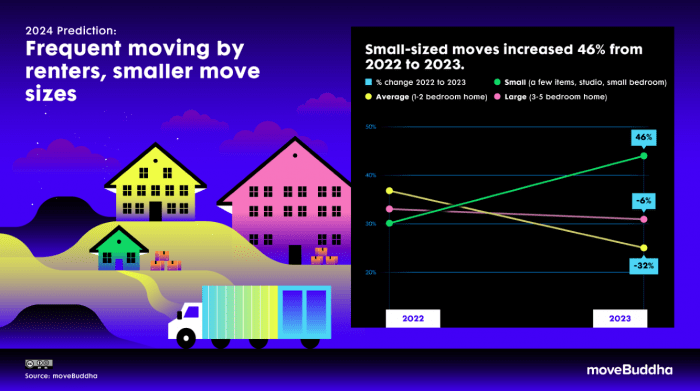
“Our prediction is a full 50% of moves in 2024 will be renters with smaller move sizes.”
Renters often have fewer possessions and obligations, making them more likely to move on the the fly. Plus, their moves aren’t impacted by home sales. With interest rates hovering at their highest levels in 30 years and home sales stagnating, it’s no wonder that 46% of 2023’s total moves were classified as “small.” Renters were still moving, but homeowners were staying put.
Carrigan states, “People who own homes aren’t moving. Only renters are moving. And renters have a lot less stuff. So in 2023, we saw the average move size drop by about 30%. Mostly because the ratio of rental moves and homeowner moves changed. So, we’ll continue to see rental moves make up a big portion of 2024 moves.”
6. Empty Office Buildings will Convert to Residential at Unprecedented Rates in 2024
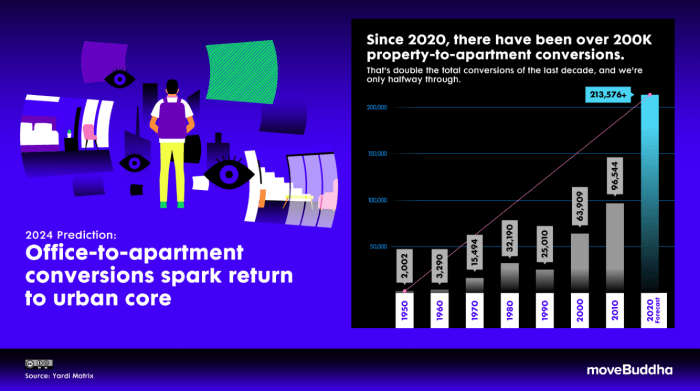
It may seem like an ironic trend, but with all that unoccupied office space, urban office conversations are all the rage.
“Residential conversion is a popular — but logistically tricky — idea that has gained traction as office buildings sit empty and cities look to revitalize their downtowns and address housing shortages,” says Seattle journalist Heidi Groover. With office vacancy rates hovering around 20% in many large cities and 22% of companies planning to reduce their use of office space even after lockdowns, developers are looking to address housing shortages with space that’s already on hand.
7. Robots May Help You Carry Those Moving Boxes

Currently, you can’t throw your moving boxes atop your robo-vac and have it pack the van. But why not? In 2022, 620,000 shipments of automation technologies absolutely dwarfed the 40,000 just 7 years ago. We think that robots handling relocations is poised for a technological upgrade this year.
After all, vacuum company Dyson is already building bots that can help with household tasks. Logistics and warehousing companies are already making use of machines with artificial intelligence (AI) to move, pack, and sort packages, while companies like Boston Dynamics handle warehouse tasks with robot dogs. While it may not help you pack your dishes…yet, an innovation in the household moving market is surely on the horizon.
2023 saw a few big moving companies close down, most notably Clutter. Some companies are thriving, some need to squeeze out efficiencies. We predict robots and automation will help more than ever in 2024.
8. Pre-Fab Will Become Economically Viable in 2024
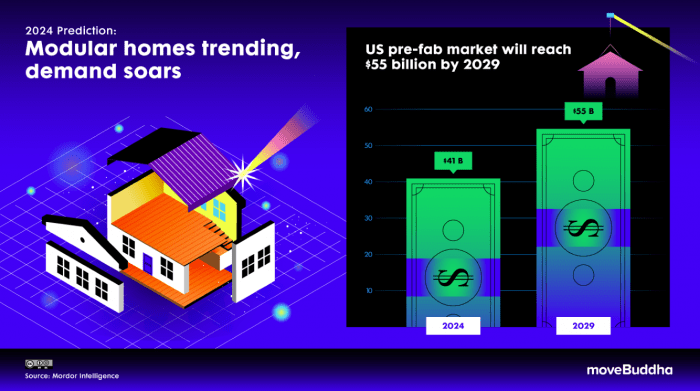
We boldly predict that pre-fab and modular housing is about to take you where no homeowner has gone before. Looking to Elon Musk’s $50K prefab made for Mars, us earthlings are set to get in on the action. In fact, the pre-fab housing market is predicted to grow about 37% by 2030, to nearly $55 billion.
Whether you’re on the red planet or in Redmond, modular housing can be built in 50% of the time, at up to 80% of the cost it would take to put up a traditional, stick-built structure. Joanna Schwartz, CEO of Quartz Properties, which uses prefab home kits, told The New York Times that buyers, “didn’t have a house in the morning and then in the afternoon they can walk through it.” Walk on, pre-fab innovators.
9. New Home Builders will Increase the Volume of Themed Communities
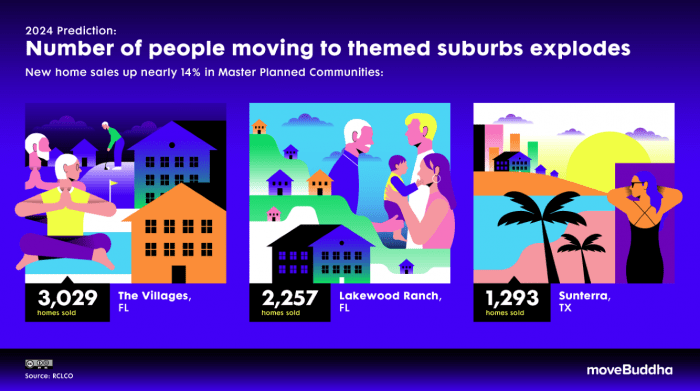
Dreaming of a “crystal lagoon?” Homebuyers are increasingly focused on cool amenities, like their very own tropical inland beach. And with new housing starts expected to increase 4.6% this year, more buyers are looking for neighborhoods that incorporate their wish lists.
We expect to see more master-planned communities with amenities like a concrete-free lifestyle, goat yoga, outdoor farms, and fishing ponds. That includes nature and open spaces, trails, green space, walkable cafés, and places to connect with one another.
2024’s Movers are Climbing the Ladder
While the pandemic saw a wave of moves from newly remote workers who could be said to be fleeing expensive cities, post-pandemic movers are more deliberate. They’re looking for a place they can settle down and enjoy a particular lifestyle.
They’re also younger, more cash-sensitive, and looking to grow their lives and careers with less stress.
That’s where many of 2024’s moving trends come in. Pre-fab homes keep costs low and create new, eco-housing. Midwest, mountain, and college towns are starting to see their lifestyle perks hit the radar. Epic suburbs are bringing lifestyle trends to cities everywhere, as these enclaves help all kinds of movers find their personal paradises.
No matter what the new year brings, our bold predictions for 2024 promise a shake-up of the status quo as well as the nation’s politics. We’ll see more action in the home market than we saw in 2023, which will expand to welcome new players and new destinations.
And if your move to a rental pre-fab in Madison doesn’t pan out, there’s always next year.
Ready to make a big move? Plan your future with our moving cost price tool to get a feel before you cancel your lease.
Not what you were looking for?
Check out other categories that can help you find the information you need!

